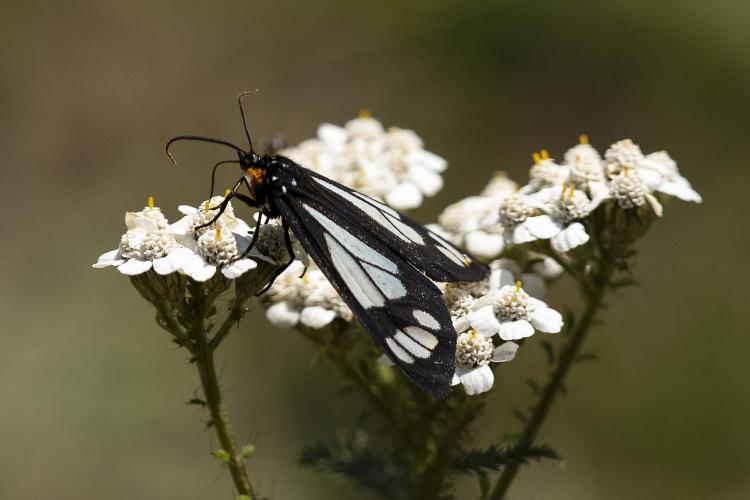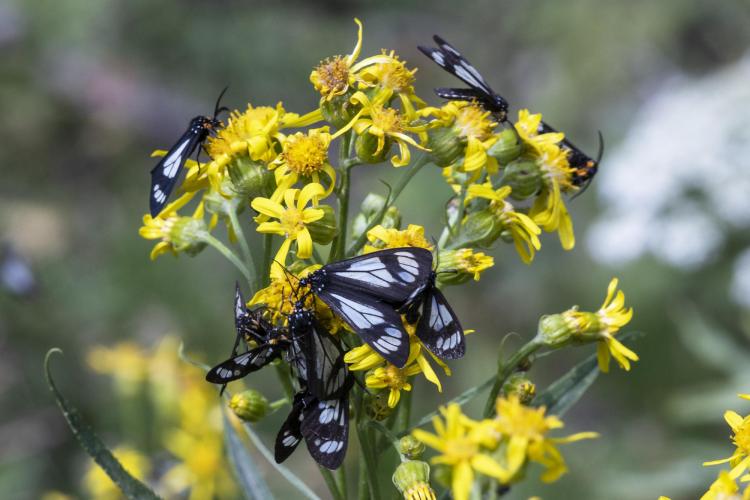Police car moths have conspicuous color patterns and fly during the day
Wielding all of these defenses, these moths have little to fear from birds or bats and they ignore photographers with impunity
Triangular leaf senecio, Senecio triangularis, is common on the eastern slope of Cimarron Ridge in the San Juan Mountains, from 9,000 to over 10,000 feet. This year they grew to five feet tall, with abundant flowers and their display was greatly enhanced by numerous police car moths, Gnophaela vermiculata. At higher elevations the moths were also on pearly everlasting, Anaphalis margaritacea, and orange sneezeweed, Helenium autumnal. I stood beside one senecio with 16 moths sipping nectar and noticed that the moths were not at all disturbed by a human within four feet.
The first tiger moth to evolve had ancestral defenses--this species is the base of the tiger moth evolutionary tree."
Five species of Gnophaela are members of the tiger moths, day flying moths that have bright colors in both caterpillars and adults, usually with striking patterns. Their ability to fly during the day and to assemble in large numbers while nectaring comes from chemical defenses that they either synthesize or take from their host plants and sequester in specific tissues. Caterpillars add contrasting black barbs that penetrate, dig in, and deliver stinging toxins. Both caterpillars and adults have combinations of brilliant black, white, blue, yellow, orange and red--aposematic color patterns warning predators of toxic defenses.

Police car moths have warning coloration to deter visual predators and ultrasonic signals to deter bats. Photo by Jeff Mitton.
Tiger moths have three classes of chemical defenses: biogenic acids (BA), pyrrolizidine alkaloids (PA) and cardiac glycosides (CG), but not all species have all three defenses. Some tiger moths modify their chemical defenses to be used in courtship displays. In addition, this group of moths is distinctive for its evolution of tymbal organs, or structures on the thorax that make ultrasonic clicks when the structures are flexed. The clicks are emitted in response to bat sonar, to warn bats of chemical defenses and in some cases, to jam the bat's radar. Some tiger moths no longer have functional tymbal organs, but their vestiges remain. Some species of tiger moths have incorporated ultrasonic clicks into courting displays.
To understand the diversity of chemical and ultrasonic defenses and uses of defensive chemical and/or ultrasonic clicks in courtship, an evolutionary tree was inferred from a large study of morphological characters. Fifty species were used to estimate the pattern of evolutionary change among the 1,100 species of tiger moths. Then the uses of BA, PA, CG and ultrasonic clicks was mapped onto the evolutionary tree to understand how the extant diversity of tiger moth defenses and courtships evolved.
The first tiger moth to evolve had ancestral defenses--this species is the base of the tiger moth evolutionary tree, the ancestor of all the extant tiger moths flying today. It synthesized BA, but lacked both PA and CG. It had bright colors, and this species evolved tymbal organs, a synapomorphic character, evolved in the ancestor and passed to all descendant species in the group--a character that distinguishes tiger moths.

Police car moths have warning coloration to deter visual predators and ultrasonic signals to deter bats. Photo by Jeff Mitton.
A new branch of the tree formed when a caterpillar evolved the enzymes and proteins needed to transfer PA from the gut into the cuticle. PA are particularly toxic, so the caterpillars defecate most of them and sequester one third in the cuticle. After modifying PA, they are incorporated into the male pheromone. Police car moths are in this group.
Multiple species switched to male pheromones without PA or added ultrasound clicks to the male courtship ritual."
Yet another branch of the tree was formed as multiple species stopped using host plants that supplied PA. Some species switched to having the adult form, but not the caterpillar, gather and sequester PA. Multiple species switched to male pheromones without PA or added ultrasound clicks to the male courtship ritual.
A last branch of the tree was added when a new species stopped synthesizing BA, and passed that trait down to its descendant species.
Police car moth caterpillars synthesize their own BA and also sequester PA from their host plants in the genus Mertensia. They utilize both tall and dwarf bluebells, consuming leaves with PAs, predominantly lycopsamine, which they modify and sequester as callimorphine. Police car moths use ultrasonic clicks to deter bats but do not employ either ultrasound or PA into courtship. Wielding all of these defenses, these moths have little to fear from birds or bats and they ignore photographers with impunity.
This article is part of Jeff Mitton's ongoing blog, Natural Selections.

